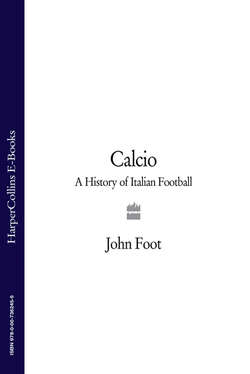Читать книгу Calcio: A History of Italian Football - John Foot - Страница 28
The Viareggio Charter. Calcio’s constitution
ОглавлениеIn 1926, the tortuous history of the Italian football federation, with its splits, rivalries and scandals, led to the imposition of unity from above. The Viareggio Charter was drawn up by three self-styled experts in the elegant seaside town that had seen the ‘football riot’ of 1920. Viareggio’s new rules revolutionized the game. First, professionalism was legalized.
This had been made inevitable by the increasing numbers of working-class footballers, who found it difficult to work and play professionally.36 It was one thing being an accountant and a professional footballer – like Fulvio Bernardini of Roma. It was quite another trying to combine other, more humble professions with the demands of a full-time national championship.
Moreover, the charter clarified the role of foreign players: they were banned. The boom in players from the new frontiers of calcio – above all Hungary and Austria – was brought to a swift halt by these new rules. There were more than 80 such players in the Italian championship in the 1925–6 season. These foreigners were all forced to find work elsewhere, or as something else. Some became managers, like the Hungarian Arpad Veisz, who won the first Serie A national championship as coach of Inter in 1929–30 and two other titles in charge of Bologna in the 1930s.
Like many Italian laws and rules, however, the charter’s procedures contained a big loophole. Who was Italian, and who was a foreigner? Banned from buying Hungarians and Austrians, the top Italian clubs began to look for ‘Italians’ amongst the millions of their fellow citizens who had left the country to find fortune elsewhere in the world. The hybrid category of the Italian oriundo (a person of Italian extraction) became part of footballing parlance. Oriundi were Italians who had been brought up or born in other countries, but were of Italian origin (an Italian grandparent was usually enough). For a long time after 1926, the history of foreigners in the Italian game – right up until the end of the 1940s, and in various phases after that – was synonymous with that of the oriundi.
Thanks to the charter, a unified national league was made inevitable by further rationalization of the championship, leading directly to a national Serie A and Serie B in 1929–30. As if to underline the central role of fascist leader Leandro Arpinati the offices of the football federation were moved to Bologna, away from the traditional centres of football power – Turin and Milan. These offices followed Arpinati to Rome in 1929, when he became undersecretary in the Interior Ministry. Finally, the Viareggio Charter abolished the referees’ association, reducing their autonomy, but increasing their prestige. A special committee was given the power to select referees for specific games. Referees remained amateurs. Giovanni Mauro, Arpinati’s ally in the 1925 Bologna ‘theft’, took control of this new body until well into the 1930s. His decisions in that 1925 final had done his career no harm at all.
